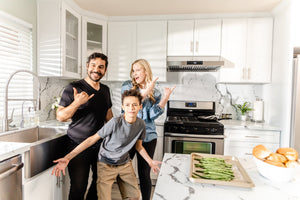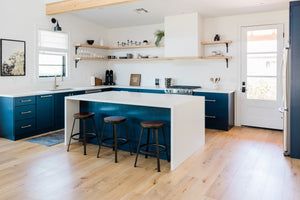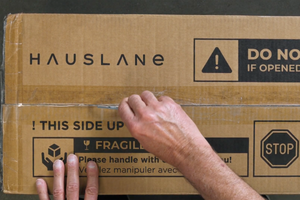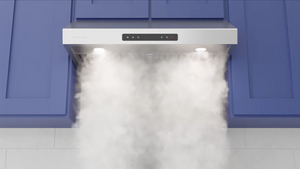How to Install A Range Hood Vent Cover
Having a range hood sure beats opening windows and doors to air out your kitchen after dinner. If you're someone who loves to switch up your kitchen style, you might be considering adding a range hood vent cover. This fun DIY project can be completed over the weekend. Here’s how to get it done.
What We'll Cover:
- Step 1: Materials and Tools
- Step 2: Install Range Hood
- Step 3: Add Side Cabinet Trim
- Step 4: Install the Frame
- Step 5: Install Angle Frame Supports
- Step 6: Attach the Range Hood Cover
- Step 7: Add Cover Trim
- Step 8: Caulk, Prime, and Paint
- Step 9: Attach Wood Board to Frame
- Step 10: Install Side Boards
- Step 11: Finish Out the Frame


1. Gather Your Materials and Tools
Before you get started, prepare all of your materials and tools in one location. You’ll want to double-check the size of your boards and make sure they measure correctly to your range hood. Make sure you have the following items to make and install your range hood vent cover:
- Miter saw
- Brad nailer
- Kreg Jig
- Circular Saw
- Measuring tape
- Clamps
- Level
- 1x6 at 8ft
- 8ft x 4ft at 1/4-inch thick plywood
- 1x2 at 8ft
- 2x2 at 8ft
- Two 1/4" x 8ft lattice board at 1/4-inch thick
- 1x4 at 3/4-inch thick boards
- 1-inch and 1 1/4-inch and 2-inch brad nails
- Two 1/2-inch screws
- Two 1/2-inch Kreg screws
- Paintable caulk
- Lightweight spackle
- Paint
- Wood stain
- Polyurethane
2. Install Your Range Hood (optional)
Of course, if you already have your range hood in place, you can skip this step! Always follow your manufacturer’s manual when installing your new range hood. We have some handy guides to help you with installation:
- How to Install the UC-PS38 Range Hood with Matt Weber of Home Improvement and Repairs
- DIY Guide to Removing Your Over-the-Range Microwave and Installing an Under Cabinet Range Hood
- How to Install a Ductless Range Hood
- Easy DIY Range Hood Installation Guide for Wall Mount Range Hoods
Not sure which range hood to buy? Our buyer’s guide is here to help!
3. Add Cabinet Side Trim (optional)
This step is optional but one you’ll want to complete if your cabinets do not have side trim pieces. Simply use the 1x2 (height should match the range hood) to create trim pieces and add them with a brad nailer.
4. Install the Frame
This step is optional but one you’ll want to complete if your cabinets do not have side trim pieces. Simply use the 1x2 (height should match the range hood) to create trim pieces and add them with a brad nailer.
5. Install Angle Frame Supports
Nail 1x2s with ¼-inch in depth to your cabinets. Then, add two 2x2s stacked on top of each other with 2-inch brad nails on each side. Take the 1x2 front angle boards past the stacked 2x2s to determine the angle you’ll need and to determine the top angle cuts. Nail the bottom part of the board into the stacked 2x2s. Finally, attach the 1x2s inside of the cabinet front corners.
6. Attach the Range Hood Cover
Use your circular saw to cut the ¼-inch plywood to size for the front cover. Secure it to the 1x2s with one-inch brad nails and a brad nailer. Clamp the plywood to trace the shape you’ll need to cut. Use a circular saw and a straight-edge guide to make the cut.
7. Add Cover Trim
Trim the front range hood cover and use 1-inch brad nails. Depending on the size of the range hood, you may want to add trim to the sides.
8. Take Care of Caulking, Priming, and Painting
Use caulk to fill all of the gaps and seams. You can fill the holes with a lightweight spackle. Prime and paint the cover with a paint color of your choosing.
9. Install the Wood Board to the Frame
To create a trim for the front of the range hood vent cover, cut out a 1x6 board. Make sure the front board has a 45 degree bevel cut on each end. The two side boards need a 90-degree end and a 45-degree bevel end.
10. Stain the Boards and Install the Side Boards
Stain the 1x6 board in a shade of your choosing. You may want to apply polyurethane to make the cover wipeable. Install the side boards with 1 ¼-inch brad nails. Nail the front board to the side boards and frame.
11. Finish Out the Frame
Use 1x4 boards with ⅜-inch thickness, paint them, and nail them into the frame to finish out the underside of the cover.
Rather not DIY? No problem. Our kitchen island, wall-mount, and built-in range hoods function beautifully without a vent cover!








